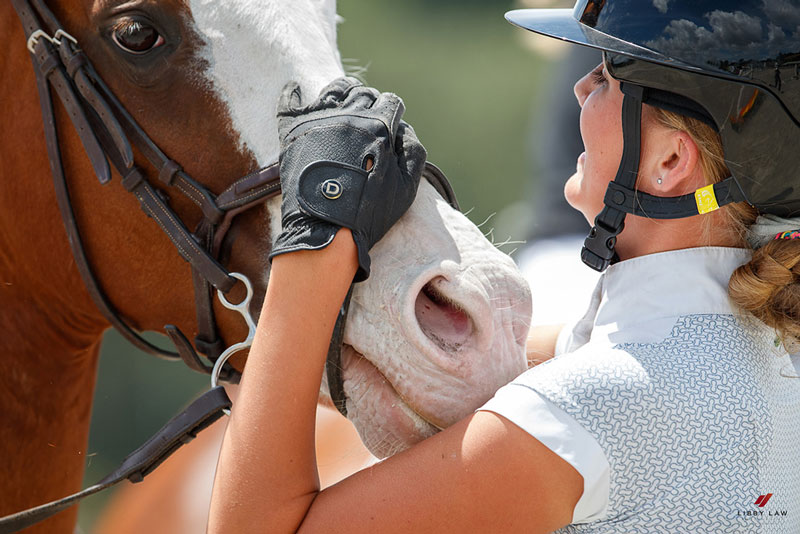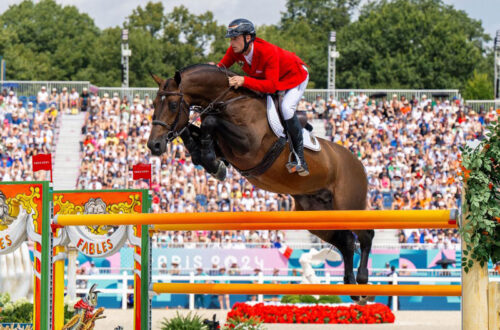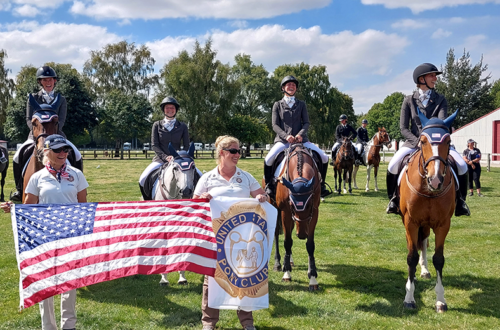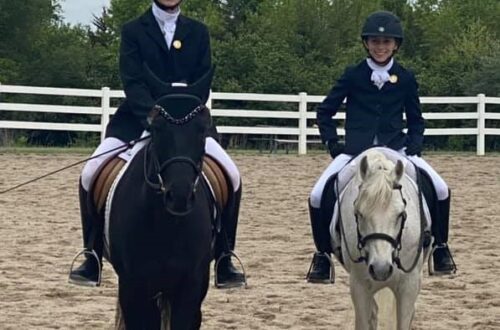
Dear Ema: Preparing for Certifications, Rider Burnout, Staying Motivated, and Jumping Exercises
By Ema Klugman, Brought to You by Ride iQ
This column from Ema Klugman, brought to you by Ride iQ, features how to prepare for a C-3 certification test; dealing with burnout as an equestrian; staying motivated to ride, especially in the winter; how to support a would-be professional, and trying new jumping exercises, including with poles.
Dear Ema,
I am preparing for my C-3 certification. I’m pretty nervous. I have read the USPC Standards of Proficiency, and I can do all of the dressage movements and jump the height that is required. But I’m not sure what else I should be doing to prepare. Do you have any advice? I really want to pass!
Sincerely,
Jackie
Dear Jackie,
How exciting that you are prepping for your C-3. Getting your C-2 and your H-B done is a big accomplishment, and kudos to you for continuing to climb the ladder.
The C-3 is a serious test, but if you prepare well, you will be fine. Study the Standards of Proficiency closely so you know exactly what to expect at the test. Remember that it’s not just a case of being able to ride the dressage movements and jump the height—you also have to demonstrate that you can explain your approach to riding and training, and you can talk about how to improve your horse going forward. For instance, if you have a rail down in the show-jumping course portion of the test, that’s not the end of the world, but you have to be able to talk about why you had the rail down and what you will do to correct it next time. Maybe you can point to your horse rushing and getting flat or that you collapsed in your position. Being able to “talk the talk” is just as important as being able to ride at these upper-level certifications.
If your region offers a mock certification test, you should attend. Treat a mock certification test just like the real test—come prepared and ready to do everything you will need to do for the real thing. Afterwards, study any feedback you receive, and work on the weak points. Think about how each part of the test went, and how your horse handled it. Ideally, you should have a few weeks or months between the mock version and the actual certification test so that you can address any deficiencies.
Another tip I would offer is to practice your warmup plan. The flat warmup is one of the first substantive parts of the certification. Make a good impression by coming prepared with a plan (down to the details—like X amount of walk, X amount of stretching trot, leg yielding both ways, then canter, then counter canter, etc.—whatever is best for your particular horse). Explain why you chose those exercises (for instance, using frequent transitions to sharpen up a lazy horse). Crucially, you also need to discuss how it’s going—are you getting the results you had hoped for in your warmup? Is your horse forward, supple, relaxed, and straight?
Always weave a discussion of the training pyramid into your discussion. And don’t be afraid to change course if your plan isn’t going as you’d hoped—that just shows the National Examiners that you can think on your feet. Be brave and walk over to the Examiners and offer to discuss your warmup—don’t wait for them to call you over. Showing that courage looks good. In addition, don’t wait for them to tell you to drop your stirrups—just go ahead and do it once your horse’s back is warmed up enough to show that you know that it’s expected and that you are confident without stirrups.
Finally, dress (both yourself and your horse) for success. First impressions are everything. When you first meet your Examiners, which may be without your horse at an initial meeting, make sure you are wearing a neat polo shirt tucked in to your breeches and your Pony Club pin. You may also want to bring a notebook to that initial meeting, because they will likely explain the schedule and any other details particular to your test. When you present your horse to the Examiners, ensure that he is turned out to the nines. He should be glowing, and your tack should be perfectly clean. Be proud of your presentation, and carry that impression throughout the entire test.
Best of luck,
Ema
Dear Ema,
I am feeling burned out. I used to really look forward to going to the barn every day, but now it’s like a chore. I don’t feel as excited about riding as I used to, and I’m thinking that I might just quit. Can you give me some inspiration to keep going?
Sincerely,
Jesse
Dear Jesse,
I’m sorry to hear that you are feeling burned out. Burnout is a real thing in the horse world—and in any industry, for that matter. I think one of the tricky things about riding horses is that it can truly be all-encompassing. It’s easy for horses to take over your life and for you to feel like everything revolves around horses. Between riding, taking care of them, planning, and paying for all of it, horses seem to affect every area of our life. But it is possible to find some separation, which can, I believe, help with burnout.
I’m not sure what hobbies or activities you do outside of horses, if any, but leaning into other things can help refresh your mind and body so that you enjoy going to the barn. It’s also okay to take a break—you can always take a few days, or weeks, away from riding. Your horse will be fine if he gets a bit of time off, as long as he’s getting good care. Although I don’t take much time off from riding, when I do, I always feel so refreshed to come back to the sport and see my horses again. The monotony of the day-to-day grind can really get to you, so some time away is healthy and good.
Another way to overcome burnout is to try a different discipline. If you are a Dressage rider, perhaps try Jumping. If you do Eventing, what’s stopping you from trying a Western discipline, like reining? Of course, you would need to make sure your horse is willing to try a different job, or perhaps you could take some lessons at a different barn to try it out on a more experienced horse first. Sometimes mixing things up can be really fun and refreshing.
Finally, I’ll say that it is okay to quit. That might be an unpopular opinion, but if you really aren’t enjoying your time at the barn, maybe riding horses isn’t actually right for you. You don’t have to ride! The other thing to remember is that you can ride at any stage of life—that’s one of the coolest things about this sport. So, you can always take a break and come back to horses in a few years, and maybe you’ll remember why you started in the first place.
Best of luck,
Ema
Dear Ema,
How can I stay motivated to ride in the winter, particularly for those who keep their horses at home and don’t have “barn friends” around to motivate them?
Sincerely,
Divya
Dear Divya,
Winters are hard! Here in Maryland, where I live, we can have very mild winters or very cold ones, depending on the year. And when we get the cold ones (like last winter), it can be really difficult to stay motivated to ride.
I am lucky to have access to an indoor arena, which really allows us to keep working the horses through the winter, even when the weather is bad. If you can ride in an indoor, even just once or twice per week, that can help you have productive rides. It’s not easy on our horses to ride them on frozen or muddy ground, so it’s best to avoid that if you can.
As for motivation, I agree that riding on your own makes it hard to feel motivated. I am often riding alone, so I try to set goals for my rides. For instance, sometimes I pick a theme for the day or week. An example could be “suppleness in the haunches-in.” For that theme, I would work with each horse on different exercises to improve the haunches-in, first in the walk, then the trot, and then the canter, incorporating it into both circles and straight lines. Having a theme for my rides prevents me from mindlessly trotting around without focusing on a goal.
If you can, try to take at least occasional lessons in the winter. Some people think that lessons are only important when you are preparing for shows, but my favorite time to take lessons is actually in the winter. This is when, in my mind, you can “take the toy apart and put it back together.” By that I mean you can really work on the basics of training and get to the bottom of any issues you are having with your horse.
If you don’t have access to a coach over the winter, I would recommend the app Ride iQ. They have some fabulous programs which you can listen to by yourself while riding. The pre-recorded audio lessons are fantastic, and you will also join a community of equestrians who use the app. I have a few lessons on the app, so look out for those if you join.
Finally, try to have some fun with it, when you can! A couple of times this past winter, I went on bareback hacks in the snow on my horses. It was cold, so I left their blankets on, and just had a nice time out hacking. These are the moments in which you build a partnership with your horses. It’s not all about training and drilling the movements of a dressage test—it’s about playing with them, enjoying them, and feeling refreshed and ready for the season when it finally rolls around.
Best of luck,
Ema
Dear Ema,
My granddaughter is horse-crazy. She loves everything about horses and would spend all day, every day in the barn if she could. I’m worried that she is putting all of her eggs in one basket. All she wants to do is ride and be a professional equestrian, but I think being a professional seems like a hard life, and I don’t want her to get disappointed or burned out. What advice do you have as I guide her through this process?
Sincerely,
Michelle
Dear Michelle,
Watching young people discover horses is always an amazing thing to witness. There is something so cool about how certain people are drawn to horses. I was one of those kids, and all these years later, the horses are what get me out of bed every morning!
I understand your concern about your granddaughter putting all of her eggs in one basket. However, she should follow her passion. If horses are what make her world go around, let her follow her passion. You should encourage her to get a good, formal education, and hopefully a college degree to fall back on, but if she wants to make a go of it in this industry, she should try. It will not be an easy lifestyle, as you suggest, but it can be so rewarding.
Even if your granddaughter doesn’t end up being a professional rider, she will learn so many life skills from riding and taking care of horses. From being responsible to learning to having a strong, tough work ethic, there are tons of skills that young people learn from being involved with horses. I also think that people can build community through horses—some of my longest and strongest friendships have come through horses.
All in all, I wouldn’t discourage her from going into horses. But if she is serious about it, you should talk to her about the sacrifices that she will have to make as a professional (we don’t get weekends off, like most normal working people do, and our hours can be rather insane!). If she can find a good professional to take her under their wing, it would be great for her to be a working student so she can see what it’s like to be a professional in this industry. And as I said, even if she doesn’t go into the industry in the long-term, she will be a better person for having followed this passion, even just for a while.
Best of luck,
Ema
Dear Ema,
What are some good exercises for jumping my horse in the winter season? I have been doing trot poles and gymnastics, but I’m looking for some more ideas.
Sincerely,
Malik
Dear Malik,
If you, like me, have been mostly stuck in an indoor arena this winter, it can be hard to jump full courses and feel like your jump training is progressing. Even if you are limited on space, you can still get creative with lots of different exercises. Let’s explore some ideas.
First, as you mentioned, doing pole work can be a wonderful asset to your training program. Because rideability is one of the most important aspects of jumping, practicing your rideability and adjustability over poles is a great way to get your horse super tuned into you. For instance, you can trot a pattern of single poles around the arena, or you can canter a pole on a circle. I often count out loud to make the rhythm clear to myself, which then translates to me riding my horses in a clear, consistent way.
Second, setting up some basic lines and being meticulous about your track is a great way to practice your accuracy. For instance, you can set up a basic five or six stride line on the long side, and then another jump on the diagonal to work into a bending line with one of the jumps on the long side. You can do the straight line, then the bending line, and then back to the straight line. Vary the number of strides in between jumps to test your ability to go forward and come back smoothly.
Third, I would recommend a variety of different grids, depending on what your horse needs to work on. There are tons of variations of grids that you can do—from bounces to two strides to using different placing poles. You can vary the width of oxers to help your horse stretch out over them, or use more ascending oxers if you are asking for a rounder jump from a slightly shorter distance. There are different grid ideas online and in books, so just be curious and be creative! Always start low and adjust the distances if they don’t feel right for your horse. Having someone on the ground is helpful as well.
Training in the off season can be challenging, but it can also be a time when you make breakthroughs with your horse if you are willing to try new and different things. Be creative and have some fun with it!
Best of luck,
Ema
Read more Dear Ema columns here. If you would like to submit a question for Ema Klugman to answer on Dear Ema, please email us at team@ride-iq.com.

About Ride iQ—An Official Partner of the United States Pony Clubs: Learn more about how Ride iQ, a mobile app with hundreds of audio riding lessons, including many Pony Club alumni and instructors. USPC and Ride iQ have partnered to identify which lessons are appropriate for each certification levels, offer exclusive deals to Pony Club members, and more. Learn more at www.ride-iq.com/pony-club.





